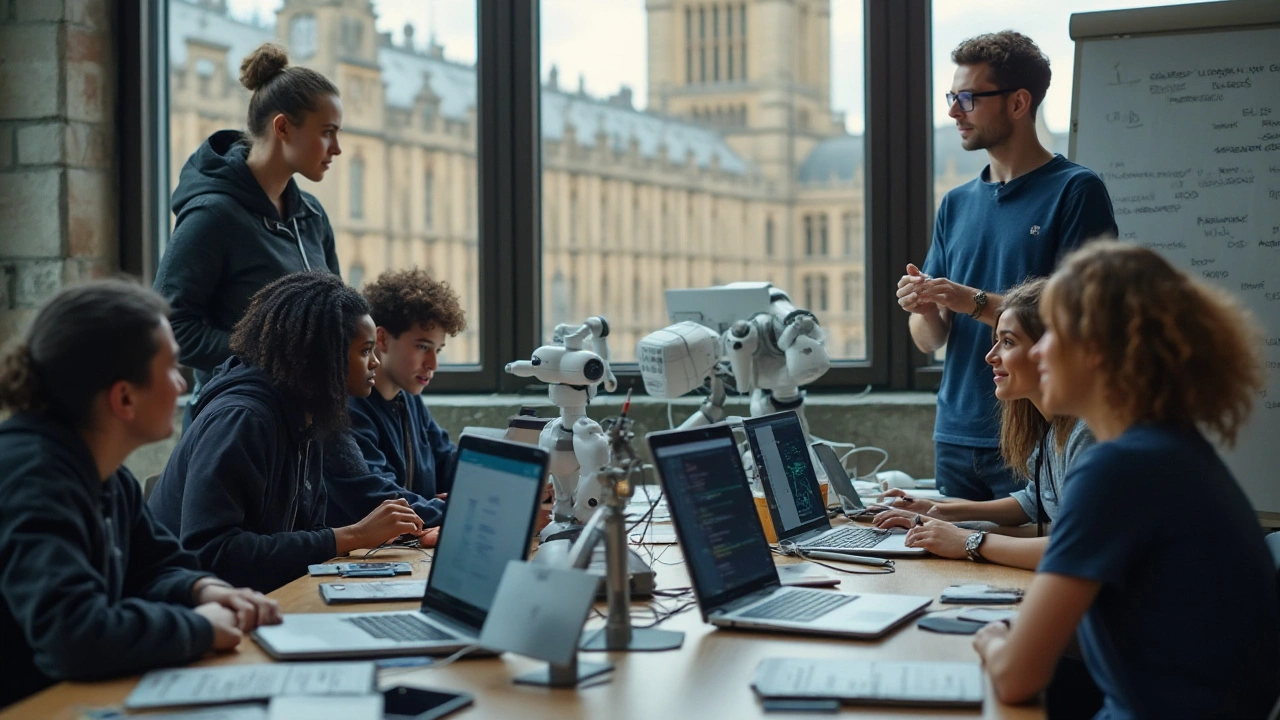Python and Artificial Intelligence: Harness the Power of Modern Programming

In today's fast-paced tech world, two buzzwords frequently catch our attention: Python and Artificial Intelligence. These aren't just fleeting trends; they are foundational elements driving significant advancements across industries.
Python's simplicity and versatility have made it a favorite among programmers, especially when it comes to AI. The language's compatibility with numerous libraries and frameworks makes it a perfect match for developing intelligent systems.
But what truly sets Python apart? Why has it become integral in AI development? Whether you're new to programming or an experienced coder, diving into the world of Python and AI can open up exciting possibilities. Read on to find out more about their synergistic power, practical applications, and how you can embark on your journey in modern programming.
- The Rise of Python in AI
- Why Python is Ideal for AI
- Popular Python Libraries for AI
- Real-Life AI Applications Using Python
- Getting Started with Python and AI
The Rise of Python in AI
Python has firmly established itself as the go-to language for artificial intelligence. This dominance didn't happen overnight. Its journey began in the early 1990s when Guido van Rossum set out to create a programming language that was both simple and powerful. Over the years, Python's popularity has grown exponentially, largely because of its readability, flexibility, and extensive community support.
Initially, Python was competing with other giants like Java and C++. What set Python apart was its user-friendly syntax, which looks almost like plain English. This simplicity made it easier for beginners to learn and has attracted a huge number of enthusiasts to the world of coding. The meteoric rise of AI and machine learning in recent years saw Python being embraced because of these very qualities. The explosion of Python in the AI space is a direct result of its ability to handle complex algorithms and data processes with ease.
One of the earliest and most vivid examples of Python’s prowess in AI was in 2012 when it played a crucial role in the resounding success of Google's Deep Learning project. This event was a major turning point that demonstrated Python's capability to handle large-scale AI problems. Python's effectiveness in building neural networks and other deep learning models has only grown since. Fast forward to today, and you would be hard-pressed to find an AI project that doesn't utilize Python in some capacity.
A remarkable feature of Python is its rich ecosystem of libraries and frameworks. Tools like TensorFlow, Keras, and PyTorch have become household names in the AI community. These libraries simplify the process of developing and deploying AI models, enabling developers to focus more on innovation rather than reinventing the wheel. As per recent surveys, PyTorch and TensorFlow rank among the top libraries used by AI developers.
According to Sebastian Raschka, a renowned machine learning researcher, 'Python has pulled ahead of other languages in the AI field due to its simplicity and robust library support.'
Another factor contributing to Python's rise is its community. The Python community is one of the most active and helpful out there. Thousands of developers contribute to an ever-growing repository of third-party modules, tutorials, and forums where solutions to almost any problem can be found. This collaborative culture has spurred innovations and allowed Python to evolve rapidly to meet the demands of new AI challenges.
Moreover, the language's versatility extends beyond AI. Python is extensively used in web development, scientific computing, data analysis, and more. The cross-disciplinary applicability means that knowledge of Python opens up various career opportunities, making it a valuable skill for professionals. Educational institutions have also recognized this and have integrated Python into their computer science syllabi, creating a steady stream of new programmers ready to join the industry.
The synergy between Python and AI has led to remarkable advancements in various sectors such as healthcare, finance, and transportation. For instance, Python-powered AI systems are now capable of diagnosing diseases, predicting stock market trends, and even self-driving cars. As technologies evolve, the collaborative potential between Python and artificial intelligence continues to grow, promising even more groundbreaking innovations ahead.
It's clear that the rise of Python in AI is no fluke. It's a testament to the language's inherent strengths and the vibrant community supporting it. Whether you’re new to programming or an experienced developer looking to explore AI, Python offers the tools and resources to help you succeed. So, why wait? Start harnessing the power of Python today, and become part of the exciting world of modern programming.
Why Python is Ideal for AI
Python’s rise in the tech industry, especially in the field of Artificial Intelligence, is hard to ignore. There are several reasons why this programming language has emerged as a favorite among developers who are venturing into AI. First and foremost, Python’s syntax is simple and intuitive, which makes it accessible for both seasoned programmers and beginners alike. Its readability reduces the complexity involved in writing and debugging code.
Another compelling reason is the extensive range of libraries and frameworks available for Python. Libraries such as TensorFlow, Keras, and Scikit-Learn provide pre-built functionalities that developers can use to build complex AI models quickly and efficiently. These tools are constantly updated by an active community, ensuring they stay relevant and powerful.
Python's versatility extends to its compatibility. It seamlessly integrates with other programming languages and technologies, making it an adaptable choice for various AI projects. Whether you’re working on modules written in Java, C++, or R, Python can bridge the gap and enhance your workflow.
The popularity of Python is further boosted by its active and supportive community. Forums, online courses, and documentation ensure that help is just a click away. This vast pool of resources can be a goldmine for those who are new to AI or seeking to troubleshoot issues in their projects.
“Python’s simplicity and readability make it an ideal choice for rapid prototyping and iterative development,” says Guido van Rossum, the creator of Python.
“I have always believed in simplicity and elegance in my code. Python encapsulates that philosophy perfectly.”
Moreover, Python enjoys industry-wide acceptance. Tech giants like Google, Facebook, and Microsoft advocate for Python in their AI research and development. Google’s AI framework, TensorFlow, was developed using Python, which speaks volumes about its efficacy and reliability in large-scale projects.
Python’s versatility isn’t just limited to language or framework compatibility. The language excels in various stages of AI implementation, including data collection, preprocessing, model training, and deployment. Its ease of use accelerates the development cycle, enabling developers to bring their ideas to life more quickly.
An important aspect that cannot be overlooked is Python’s performance. While it might not be the fastest language compared to C++ or Java, its efficiency in handling AI tasks is remarkable. With the help of just-in-time compilers like PyPy, Python's performance can be optimized to meet the demands of high-speed computations.

Popular Python Libraries for AI
When it comes to Python and AI, several libraries stand out for their powerful capabilities and ease of use. These tools are essential for anyone looking to dive into artificial intelligence development with Python. They offer pre-built functions that make it easier to process data, build models, and deploy applications.
TensorFlow
Developed by Google, TensorFlow is an open-source library that's become a cornerstone in AI and machine learning. Its flexibility and comprehensive ecosystem make it a preferred choice for both researchers and industry professionals. TensorFlow supports deep learning applications and is especially favored for neural networks. One of the standout features of TensorFlow is its ability to run on multiple CPUs and GPUs, making it highly scalable.“TensorFlow has become the gold standard for training, deploying, and managing machine learning models.” – Google AI Team
Keras
Keras acts as a high-level API for building and training deep learning models, and it's usually bundled with TensorFlow. Its concise and readable code makes it an excellent tool for quick prototyping. Keras supports both convolutional and recurrent networks, making it versatile for various AI applications. It's user-friendly, making it ideal for beginners diving into AI with Python.PyTorch
Developed by Facebook’s AI Research lab, PyTorch is another popular library used extensively in both academic and industrial settings. Known for its flexibility and intuitive design, PyTorch has gained significant traction among researchers for developing novel AI models. One key advantage of PyTorch is its dynamic computational graph, which makes debugging easier and speeds up the development process.Scikit-Learn
If you're dealing with classic machine learning algorithms, Scikit-Learn is the go-to library. Created by David Cournapeau, it features simple and efficient tools for data mining and data analysis. Scikit-Learn is built on NumPy, SciPy, and matplotlib, providing an integrated environment for machine learning. It’s perfect for tasks like classification, regression, and clustering, offering modules for each.OpenCV
OpenCV is an open-source computer vision library widely used in both academia and industry. Its Python bindings make it accessible to AI enthusiasts and professionals alike. OpenCV is particularly useful for real-time computer vision applications and comes with modules for image processing, machine learning, and video analysis. Given its robust community support and extensive documentation, it's a valuable addition to any AI developer's toolkit.Using these libraries, developers can handle a wide array of tasks with relative ease. From deep learning to image processing, each library has its strengths and ideal use cases, making Python an incredibly flexible and powerful language for AI development.
Real-Life AI Applications Using Python
When we talk about Artificial Intelligence and its real-world applications, the significance of Python can't be overstated. Python isn't just a trendy language; it has become indispensable in the AI realm due to its ease of use and powerful libraries. From healthcare to entertainment, Python-powered AI is making waves. Let's look at some compelling examples.
One of the most talked-about applications is in healthcare. AI algorithms written in Python are being used for early diagnosis and treatment predictions. For instance, IBM's Watson uses AI to help in diagnosing diseases more accurately. It reviews and interprets a huge database of medical journals, patient records, and clinical studies to assist doctors in making decisions. This advanced diagnosis wouldn't be possible without Python-based algorithms handling the mountain of data.
Another fascinating application is in autonomous vehicles. Companies like Tesla rely heavily on Python to develop their self-driving technologies. Autonomous systems need to process a tremendous amount of visual data from cameras in real-time. Python libraries like OpenCV and TensorFlow have become the backbone of these systems. They enable the vehicle to identify objects like pedestrians and other cars, ensuring a safer driving experience.
In the world of finance, algorithmic trading is a game-changer. Python-powered AI models can analyze market trends and make trades faster than any human. QuantConnect, for instance, uses Python to allow traders to create, backtest, and deploy trading algorithms. This ability to handle large datasets and make lightning-fast decisions has made Python a staple in the financial sector.
Ever wondered how streaming services like Netflix recommend what to watch next? Python-driven recommendation systems analyze your viewing history, compare it with millions of other users, and suggest shows or movies you might enjoy. These algorithms rely on libraries such as Scikit-learn and Pandas to provide a personalized viewing experience.
In retail, companies like Amazon use Python-based AI for inventory management, customer service, and even for predicting future sales. Machine learning algorithms can analyze trends and forecast when certain items will be in high demand. This allows businesses to manage stock more efficiently, which reduces costs and improves customer satisfaction.
"Python's simplicity and readability have made it the top choice for AI applications." — Marcus Borba, AI Expert
But it’s not just industries that are benefiting; Python and AI are also making strides in the environment and conservation fields. Machine learning models are used to analyze climate data to make more accurate weather forecasts. Python helps researchers track animal populations and predict poaching activities, aiding in wildlife conservation efforts.
As you can see, the synergy between Python and Artificial Intelligence offers endless opportunities across various domains. Whether it's saving lives, driving cars, or getting you hooked on the next great TV series, Python and AI are silently working in the background to make our lives easier and more enjoyable.

Getting Started with Python and AI
Taking your first steps into the world of Python and Artificial Intelligence might seem daunting, but it's an exciting journey that promises great rewards. The combination of Python's user-friendly syntax and powerful AI capabilities opens a realm of possibilities, whether you’re interested in machine learning, deep learning, or natural language processing.
First, let’s set the stage with some basic tools. Installing Python is straightforward; head over to the official Python website and download the latest version. Alongside Python, you might want to install an Integrated Development Environment (IDE) like PyCharm or Jupyter Notebook, which offers a more interactive way of writing and testing your code.
Once you have your environment ready, the next step is to familiarize yourself with some essential Python libraries for AI development. Libraries like TensorFlow, Keras, and PyTorch are crucial as they simplify the development of complex neural networks. For example, TensorFlow was developed by the Google Brain team and offers an extensive range of tools that make building AI models easier.
"The best way to get started with AI is to dive into some hands-on projects. Theory is important, but nothing beats practical experience." — Andrew Ng, co-founder of Coursera and AI pioneer.
Getting your hands dirty with real code is invaluable. Start with simple projects like developing a chatbot or a recommendation system. These types of projects allow you to apply what you’ve learned and give you a better understanding of how AI algorithms work in real scenarios.
Education is a continuous process, especially in a rapidly evolving field like AI. There are numerous online platforms offering courses tailored to all skill levels. Websites like Coursera, Udemy, and edX provide in-depth courses that cover all aspects of AI and machine learning, from basic to advanced levels. Following structured learning paths can be particularly beneficial as they guide you through the essentials step-by-step.
Building Your First AI Model
One of the best ways to understand AI is to build a simple model. Say you want to create a basic image recognition system. Start by collecting a dataset, which you can often find open-source online. Use a convolutional neural network (CNN) for the task, as they are particularly effective for image data. Using Python and a library like Keras, you can set this up fairly easily. Here's an outline:
- Preprocess your data to standardize the images.
- Build your CNN architecture with layers for convolution, pooling, and fully-connected nodes.
- Train your model using the dataset.
- Test the model to evaluate its accuracy.
One last point to consider is joining a community. Being part of a community, whether online forums like Stack Overflow or local meetups, gives you access to collective knowledge and support, which can be extremely helpful as you navigate challenges and new learning curves.
Embarking on your Python & AI journey is thrilling, full of learning and innovation. The tools at your disposal are powerful and accessible, making it a great time to dive into the world of modern programming.